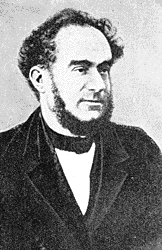كارلو ماتوتشي
Carlo Matteucci | |
|---|---|
 | |
| وُلِدَ | 20 يونيو 1811 |
| توفي | 25 يونيو 1868 (aged 57) |
| القومية | Italian |
| المدرسة الأم | جامعة بولونيا (PhD) (1829) |
| عـُرِف بـ | Matteucci effect |
| الجوائز | وسام كوپلي (1844) |
| السيرة العلمية | |
| المجالات | Physics Neurophysiology |
| الهيئات | University of Pisa |
كارلو ماتوتشي ( Carlo Matteucci ؛ 20 أو 21 يونيو 1811 – 25 يونيو 1868) كان فيزيائياً إيطالياً وعالم فسيولوجيا عصبية كان رائداً في دراسة الكهرباء الحيوية.
السيرة
Carlo Matteucci was born at Forlì, in the province of Romagna, to Vincenzo Matteucci, a physician, and Chiara Folfi. He studied mathematics at the University of Bologna from 1825 to 1828, receiving his doctorate in 1829.[1] From 1829 to 1831, he studied at the École Polytechnique in Paris, France. Upon returning to Italy, Matteucci studied at Bologna (1832), Florence, Ravenna (1837) and Pisa. He established himself as the head of the laboratory of the Hospital of Ravenna and became a professor of physics at the local college. In 1840, by recommendation of François Arago (1786–1853), his teacher at the École Polytechnique, to the Grand-Duke of Tuscany, Matteucci accepted a post of professor of physics at the University of Pisa.
Instigated by the work of Luigi Galvani (1737–1798) on bioelectricity, Matteucci began in 1830 a series of experiments which he pursued until his death in 1865. Using a sensitive galvanometer of Leopoldo Nobili, he was able to prove that injured excitable biological tissues generated direct electrical currents, and that they could be summed up by adding elements in series, like in Alessandro Volta’s (1745-1827) electric pile. Thus, Mateucci was able to develop what he called a "rheoscopic frog", by using the cut nerve of a frog's leg and its attached muscle as a kind of sensitive electricity detector. His work in bioelectricity influenced directly the research developed by Emil du Bois-Reymond (1818–1896), a student of the great German biologist Johannes Peter Müller (1801–1858) in Berlin, who tried the duplicate Matteucci's experiments and ended up discovering the nerve's action potential. In 1844, for these studies, Matteucci was awarded with the Copley medal by the Royal Society.
From 1847, he took an active part in politics, and in 1860 was chosen an Italian senator, at the same time becoming inspector-general of the Italian telegraph lines. Two years later he was appointed Minister of Education.
Matteucci died in the Ardenza neighbourhood of Livorno in 1868.
الأعمال
Matteucci was the author of four scientific treatises in physics:
- Lezioni di fisica (2 vols., Pisa, 1841)
- Lezioni sui fenomeni fisico-chimici dei corpi viventi (Pisa, 1844)
- Manuale di telegrafia electrica (Pisa, 1850)
- Cours spécial sur l'induction, le magnétisme de rotation, etc. (Paris, 1854).
- Trattato dei fenomeni elettrofisiologici degli animali (1844)
- Lezioni di fisica [Physics lessons] (in الإيطالية). Pisa: Pieraccini. 1850.
- Corso di elettrofisiologia (1857)
- Corso di elettro-fisiologia [Course in Electro-physiology] (in الإيطالية). Torino: Castellazzo e Vercellino. 1861.
His numerous papers were published in the Annales de chimie et de physique (1829–1858); and most of them also appeared at the time in the Italian scientific journals. They relate almost entirely to electrical phenomena, such as the magnetic rotation of light, the action of gas batteries, the effects of torsion on magnetism,[2] the electric polarization of electrodes, etc., sufficiently complete accounts of which are given in Wiedemann's Galvanismus.
Nine memoirs, entitled Electro-Physiological Researches, were published in the Philosophical Transactions, 1845–1860. See Bianchi's Carlo Matteucci e l’Italia del suo tempo (Rome, 1874).
انظر أيضاً
ببليوجرافيا
- Matteucci C., "Sur un phenomene physiologique produit par les muscles en contraction", Ann. Chim. Phys. 1842, 6, 339–341.
المراجع
- ^
 [[wikisource:Catholic Encyclopedia (1913)/Carlo Matteucci "|Carlo Matteucci]"]. Catholic Encyclopedia. New York: Robert Appleton Company. 1913.
[[wikisource:Catholic Encyclopedia (1913)/Carlo Matteucci "|Carlo Matteucci]"]. Catholic Encyclopedia. New York: Robert Appleton Company. 1913. {{cite encyclopedia}}: Check|url=value (help) - ^ Matteucci, C. (1858). "Recherches expérimentales sur les phénomènes électromagnétiques développés par la torsion" [Experimental research on electromagnetic phenomena developed by torsion]. Annales de Chimie et de Physique (in الفرنسية). 53 (385).
- This article incorporates text from a publication now in the public domain: Chisholm, Hugh, ed. (1911). . دائرة المعارف البريطانية (eleventh ed.). Cambridge University Press.
{{cite encyclopedia}}: Cite has empty unknown parameter:|coauthors=(help)
وصلات خارجية
 Media related to كارلو ماتوتشي at Wikimedia Commons
Media related to كارلو ماتوتشي at Wikimedia Commons
- CS1 errors: URL
- CS1 الفرنسية-language sources (fr)
- Short description is different from Wikidata
- Articles containing إيطالية-language text
- CS1 الإيطالية-language sources (it)
- Articles containing فرنسية-language text
- Articles containing ألمانية-language text
- مقالات المعرفة المحتوية على معلومات من دائرة المعارف البريطانية طبعة 1911
- Wikipedia articles incorporating text from the 1911 Encyclopædia Britannica
- مواليد 1811
- وفيات 1868
- Education ministers of Italy
- فيزيائيون إيطاليون في القرن 19
- Italian neuroscientists
- حائزو وسام كوپلي
- أشخاص من فورلي
- Members of the Senate of the Kingdom of Sardinia
- خريجو جامعة بولونيا
- خريجو المدرسة متعددة التكنولوجيات بپاريس
